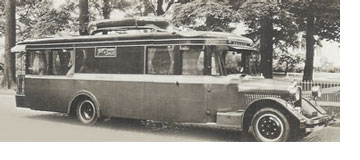


In 1927 Leonard S. Whittier, of Elmira, New York, had a custom built recreation vehicle, long before it became part of the American way of life. The traveling home was christened "Flordellen" using the name of his wife, Florence, son David Lane and his own. Although none of the pictures obtained thus far show any the carved interior it is believed that Charles S.Hall did the interior woodwork in this vehicle. The data collected does indicate carved panels on the desk and other "fancy" woodwork. Further investigation will be necessary to conclude that, in fact, Charles Hall did the carving in this vehicle. Till that time I offer you the information that I do have in hopes that someone knows the location (if it still exists) of this de luxe land yacht.
Leonard S. Whittier was born in Chicago, June 16, 1883, the son of David Lane and Mary Wishard Whittier. David Lane Whittier established the Eclipse Bicycle Co. at Indianapolis. He transferred that business to Elmira Heights by invitation of the Elmira Industrial Association in 1895. Upon graduation from Mercersburg Academy, Leonard joined the Eclipse Machine Co. He rose to secretary and treasurer and was secretary when he retired in June 1924. He was one of four principal owners of the Eclipse Machine Company which manufactured the Bendix starter drive and other mechanical devices for automobiles, motorcycles and bicycles. He purchased this motor home, built to his specifications, for many trips to New York City, to Churchill Downs, Kentucky, to Florida for the winter and other places and cities. This motor home, or land yacht, was built by Whitfield & Sons, Inc., a maker of bus bodies in Penn Yan, NY. Of "parlor car" construction, it was equipped with the finest conveniences including carved wood work and even its own engraved stationery.
The car was 31 feet long, 9 feet 2 inches high and 7 feet 6 inches wide, practical for state roads and over head bridges of the time. Built on a Brockway model "H" bus chassis with a 200-inch wheelbase and a frame extension to take the long body, measuring over 30 feet from front bumper to observation platform. It had an automatic Kohler Electric Plant, a Model D, of 1,500-2,000 watt capacity which furished light and power for all the appliances found in a modern home of the ninteen thirties. It had electric heaters, a Frigidaire electric refrigerator (the only electric refrigerator made at the time), and an electric stove and oven. Air pressure operated the water fed bathroom and kitchenette fans and forced draft through aerating ventilators on the roof over the kitchen and toilet. A six volt lighting and ventilating system was installed for convenience as an auxiliary to the 100 volt circuit.
The master quarters had accommodations for two with a Pullman style bed, wicker chairs, wardrobe, bookcases, built-in radio system, spinet desk with hand-carved panel and ample storage space in the lockers and cupboard. The interior trim was in gray-green leather with crepe-mohair drapes of orange, green and brown stripes. The woodwork was done in mahogany.
The Frigidaire refrigerator and the sink were on one side of the kitchen, with the electric stove and water heater opposite. On the right side of the vehicle was a complete bathroom, finished in cream-colored tile with green trim. There was a shower bath, complete with a curtain and rubber tiled floor, and a chemical toilet with a large septic tank beneath the floor. Bronze pendant light fixtures with a shaving mirror and medicine chest hung over the white porcelain lavatory bowl.
The driver's compartments contained accommodations for two people. Lounging chairs, a modified form of Morris chairs, used during the day became single beds at night. Bronze screens at the windows and ventilator openings added to comfort on the road. Protex wire glass was used on all windows. Marine instruments for weather forecast, ships clock, chart board, cigarette lighters and mirrors were included and added to the "land yacht" aspect of the vehicle.
The traveling home was designed to afford the utmost comfort. The chauffeur's luggage, tent and bedding were carried on the roof, nestled in the canoe which was inverted. The outside body was paneled in aluminum, finished in green and cream with mouldings in light tan. A chime whistle added to the trim of the vehicle. There was an observation platform, at the rear of the vehicle, with four metal chairs, and trimmed with awning strips. This was reached through the back door of the owner's salon, and lends a finishing touch to the body. Abord the elegant cruiser are, from left to right, Dick Hall, Leah Hall, Leonard Whittier, and Florence Whittier. It is not known if Dick and Leah Hall are related to Charles S. Hall--yet another question to answer.